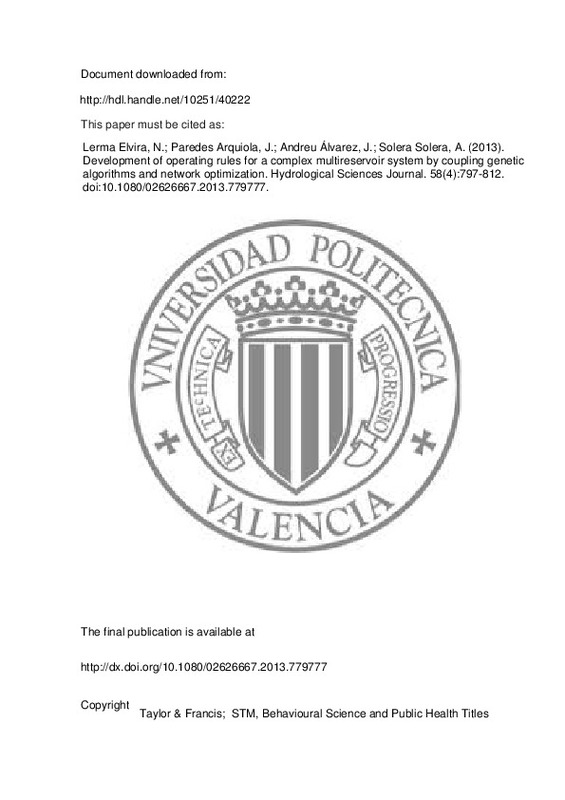JavaScript is disabled for your browser. Some features of this site may not work without it.
Buscar en RiuNet
Listar
Mi cuenta
Estadísticas
Ayuda RiuNet
Admin. UPV
Development of operating rules for a complex multireservoir system by coupling genetic algorithms and network optimization
Mostrar el registro sencillo del ítem
Ficheros en el ítem
| dc.contributor.author | Lerma Elvira, Néstor
|
es_ES |
| dc.contributor.author | Paredes Arquiola, Javier
|
es_ES |
| dc.contributor.author | Andreu Álvarez, Joaquín
|
es_ES |
| dc.contributor.author | Solera Solera, Abel
|
es_ES |
| dc.date.accessioned | 2014-09-25T10:06:15Z | |
| dc.date.available | 2014-09-25T10:06:15Z | |
| dc.date.issued | 2013-05-01 | |
| dc.identifier.issn | 0262-6667 | |
| dc.identifier.uri | http://hdl.handle.net/10251/40222 | |
| dc.description | This is an Accepted Manuscript of an article published in Hydrological Sciences Journal on MAY 1 2013, available online: http://dx.doi.org/10.1080/02626667.2013.779777 | es_ES |
| dc.description.abstract | [EN] An alternative procedure for assessment of reservoir Operation Rules (ORs) under drought situations is proposed. The definition of ORs for multi-reservoir water resources systems (WRSs) is a topic that has been widely studied by means of optimization and simulation techniques. A traditional approach is to link optimization methods with simulation models. Thus the objective here is to obtain drought ORs for a real and complex WRS: the Júcar River basin in Spain, in which one of the main issues is the resource allocation among agricultural demands in periods of drought. To deal with this problem, a method based on the combined use of genetic algorithms (GA) and network flow optimization (NFO) is presented. The GA used was PIKAIA, which has previously been used in other water resources related fields. This algorithm was linked to the SIMGES simulation model, a part of the AQUATOOL decision support system (DSS). Several tests were developed for defining the parameters of the GA. The optimization of various ORs was analysed with the objective of minimizing short-term and long-term water deficits. The results show that simple ORs produce similar results to more sophisticated ones. The usefulness of this approach in the assessment of ORs for complex multi-reservoir systems is demonstrated. | es_ES |
| dc.description.sponsorship | The authors wish to thank the Confederacion Hidrogrofica del Jucar (Spanish Ministry of the Environment) for the data provided in developing this study and the Comision Interministerial de Ciencia y Tecnologia, CICYT (Spanish Ministry of Science and Innovation) for funding the projects INTEGRAME (contract CGL2009-11798) and SCARCE (programme Consolider-Ingenio 2010, project CSD2009-00065). The authors also thank the European Commission (Directorate-General for Research and Innovation) for funding the project DROUGHT-R&SPI (programme FP7-ENV-2011, project 282769) and the Seventh Framework Programme of the European Commission for funding the project SIRIUS (FP7-SPACE-2010-1, project 262902). We are grateful to the reviewers for their valuable comments, which have improved this paper. | en_EN |
| dc.language | Inglés | es_ES |
| dc.publisher | Taylor & Francis; STM, Behavioural Science and Public Health Titles | es_ES |
| dc.relation.ispartof | Hydrological Sciences Journal | es_ES |
| dc.rights | Reserva de todos los derechos | es_ES |
| dc.subject | Water resources system | es_ES |
| dc.subject | Genetic algorithms | es_ES |
| dc.subject | PIKAIA | es_ES |
| dc.subject | Operating rules | es_ES |
| dc.subject | Decision support system | es_ES |
| dc.subject | AQUATOOL | es_ES |
| dc.subject | Simulation | es_ES |
| dc.subject | Optimization | es_ES |
| dc.subject | Agricultural demands | es_ES |
| dc.subject | Drought | es_ES |
| dc.subject | Deficits | es_ES |
| dc.subject.classification | INGENIERIA HIDRAULICA | es_ES |
| dc.title | Development of operating rules for a complex multireservoir system by coupling genetic algorithms and network optimization | es_ES |
| dc.type | Artículo | es_ES |
| dc.identifier.doi | 10.1080/02626667.2013.779777 | |
| dc.relation.projectID | info:eu-repo/grantAgreement/EC/FP7/282769/EU/Fostering European Drought Research and Science-Policy Interfacing/ | es_ES |
| dc.relation.projectID | info:eu-repo/grantAgreement/MICINN//CGL2009-11798/ES/Integración de metodologías multidisciplinares en la planificación hidrológica dentro del ámbito de la Directiva Marco Europea en política de aguas/ | es_ES |
| dc.relation.projectID | info:eu-repo/grantAgreement/EC/FP7/262902/EU/Sustainable Irrigation water management and River-basin governance: Implementing User-driven Services/ | es_ES |
| dc.relation.projectID | info:eu-repo/grantAgreement/MICINN//CSD2009-00065/ES/Evaluación y predicción de los efectos del cambio global en la cantidad y la calidad del agua en ríos ibéricos/ | es_ES |
| dc.rights.accessRights | Abierto | es_ES |
| dc.contributor.affiliation | Universitat Politècnica de València. Instituto Universitario de Ingeniería del Agua y del Medio Ambiente - Institut Universitari d'Enginyeria de l'Aigua i Medi Ambient | es_ES |
| dc.contributor.affiliation | Universitat Politècnica de València. Departamento de Ingeniería Hidráulica y Medio Ambiente - Departament d'Enginyeria Hidràulica i Medi Ambient | es_ES |
| dc.description.bibliographicCitation | Lerma Elvira, N.; Paredes Arquiola, J.; Andreu Álvarez, J.; Solera Solera, A. (2013). Development of operating rules for a complex multireservoir system by coupling genetic algorithms and network optimization. Hydrological Sciences Journal. 58(4):797-812. https://doi.org/10.1080/02626667.2013.779777 | es_ES |
| dc.description.accrualMethod | S | es_ES |
| dc.relation.publisherversion | http://dx.doi.org/10.1080/02626667.2013.779777 | es_ES |
| dc.description.upvformatpinicio | 797 | es_ES |
| dc.description.upvformatpfin | 812 | es_ES |
| dc.type.version | info:eu-repo/semantics/publishedVersion | es_ES |
| dc.description.volume | 58 | es_ES |
| dc.description.issue | 4 | es_ES |
| dc.relation.senia | 245805 | |
| dc.contributor.funder | European Commission | |
| dc.contributor.funder | Ministerio de Ciencia e Innovación |







![[Cerrado]](/themes/UPV/images/candado.png)

